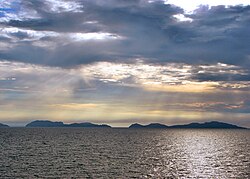Gigantes Sur

North and South Gigante Islands seen from the Visayan Sea
|
|
| Geography | |
|---|---|
| Coordinates | 11°35′39″N 123°20′11″E / 11.59417°N 123.33639°ECoordinates: 11°35′39″N 123°20′11″E / 11.59417°N 123.33639°E |
| Adjacent bodies of water | |
| Total islands | 10 |
| Major islands |
|
| Administration | |
| Region | Western Visayas |
| Province | Iloilo |
| Municipality | Carles |
| Barangays |
|
| Demographics | |
| Population | 12,224 (2010) |
Islas de Gigantes (variously Islas Gigantes, Higantes group, or Gigantes group) is an island chain within the larger Western Visayas archipelago in the Visayan Sea. It is part of the municipality of Carles, Iloilo, Philippines, and the northernmost part of Iloilo province. The Gigantes Islands consist of about ten islands; the two largest are Gigantes Norte (North Gigantes) and Gigantes Sur (South Gigantes). According to the 2010 census, it has a population of 12,224. There is also a lighthouse on Gigantes Norte.
The Gigantes islands are located roughly 18 kilometres (11 mi) from Panay Island in the Visayan Sea. Gigantes Norte is 213 metres (699 ft) at its highest point, while Gigantes Sur is 232 metres (761 ft) at its highest point. A narrow 0.80-kilometre (.5 mi) wide channel separates the two islands. Nearby islands include Balbagon Island, which is 6 kilometres (3.7 mi) west of Gigantes Sur and is part of barangay Lantangan.
In addition to the two main islands, the Gigantes group includes the following minor islets: Bulubadiang, Gigantillo, and Gigantuna are islets southeast of Gigantes Norte, while Antonia, Bantigui, Cabugao, Tanguingui, and Turnina are islands and islets south of Gigantes Sur.
The Gigantes group consists of the following four barangays. On Gigantes Norte is Asluman and Granada and on Gigantes Sur is Lantangan and Gabi.
The Gigantes group used to be called Sabuluag or Salauag, which is the name of a species of tree endemic to the islands. During the Spanish colonial era, the name was changed to Gigantes. Local legend describes coffins found inside Bakwitan Cave that contained gigantic sets of human bones, which constituted the name change. For this reason, locals also believe the island is inhabited by enkantos.
A lighthouse was built on Gigantes Norte some time before 1895. Designated ARLHS PHI-094, the white 38-foot (12 m) high tower features a keeper's house and a focal point 77 feet (23 m) in the air, which flashes once every ten seconds. Lantangan Elementary School in Gigantes Sur has a student population of 1,144, which is higher than the populations of mainland schools.
...
Wikipedia

